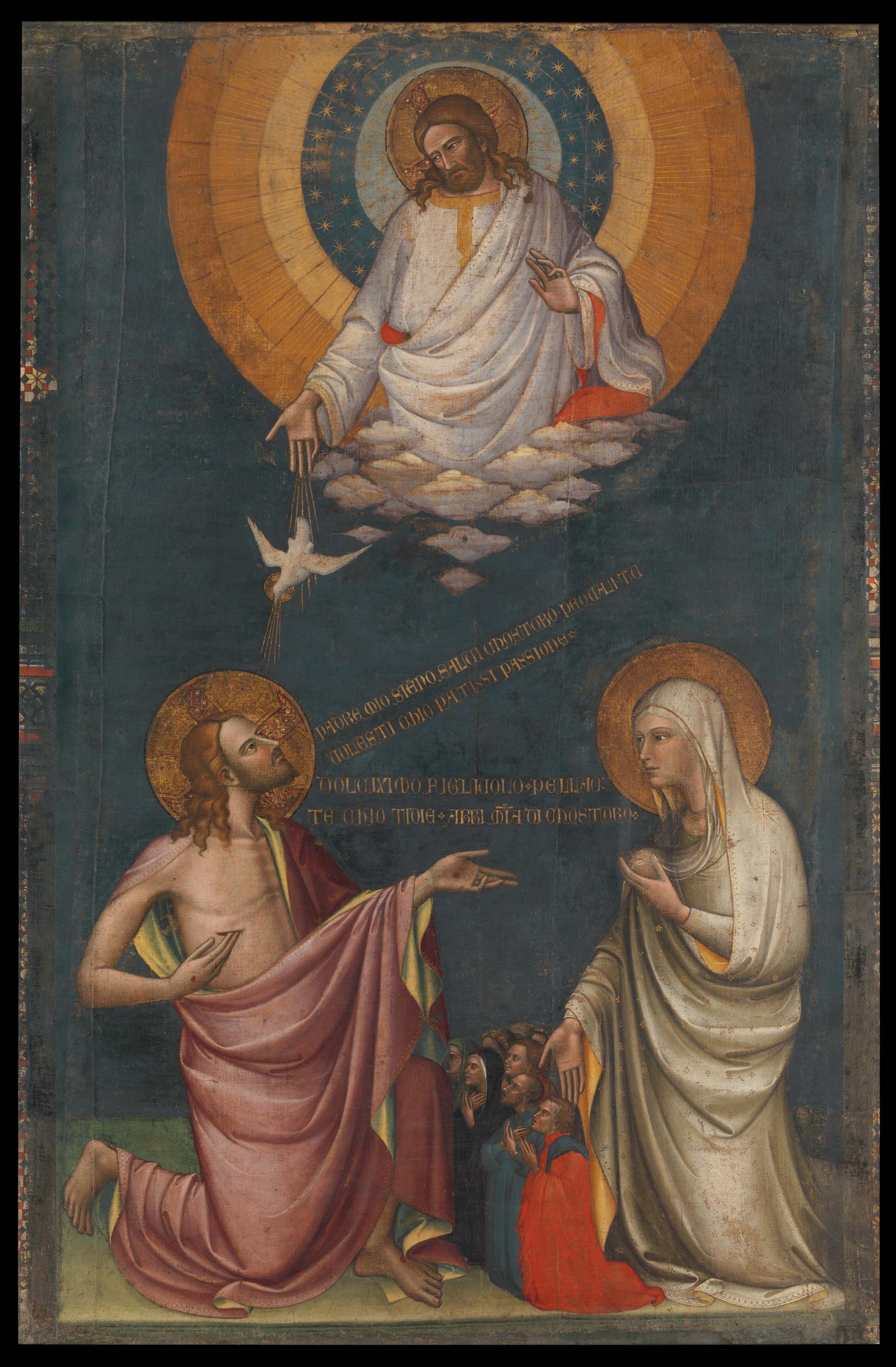
The Intercession of Christ and the Virgin
Many times in these columns, I have reflected upon particular works of art which reflect the unique role of Mary in the life of the Trinity and in the life of the Church. This summer, I happened to come upon one which I never noticed before in the medieval hall of the Metropolitan Museum of Art in New York titled The Intercession of Christ and the Virgin. It is a painting that stood behind the altar in the Trinity Chapel at the Cathedral of Santa Maria del Fiore in Florence, Italy. It was painted before 1402.
In the painting, Jesus and Mary are kneeling and praying to heaven on behalf of the human race and interceding for us. From heaven, the image of God, the Father, is visible, sending the Holy Spirit down in answer to their prayers. There are other paintings from the Middle Ages of a similar scene and title. Like other works of art regarding the role of Mary, this painting emphasizes the belief of the Church in the unique role which she had in our redemption, as well as in the life of Christ and the Trinity as God called her to be part of our redemption in a unique manner.
September holds a few feasts in honor of Our Lady. While the month of September is not dedicated to Mary, as are October and May, it is a good month to keep Mary before us as she intercedes for us. Sept. 8 was the celebration of the Nativity of Mary. Since it fell on Sunday this year, it was not formally celebrated at Mass. Celebrating the birthday of a saint is not the usual norm for the Church. The Church celebrates the day on which the saint passed from this life and entered into eternal life. The Church considers that the true birthday of the person. There are only three natal birthdays in the liturgical year — those of Christ, Mary and John the Baptist. The Church also celebrates the birth of Mary into eternal life on the feast of the Assumption as well as that of John the Baptist on the feast of his Beheading. Mary’s birthday in September reminds us of the prominent place that she plays in the life of the Church and in the lives of each one of us. It reminds us that her coming into the world, like that of Christ Himself, was the beginning of the new covenant of God’s relationship with us.
Sept. 12 was the celebration of the Most Holy Name of Mary. Invoking the name of a person and paying special respect to that name have their roots in the sacred tradition of the Old Testament in regard to the very name of God Himself. The only other name which the Church celebrates is that of the Holy Name of Jesus. The special respect paid to the name of Mary points us to the name of Christ and the centrality of His presence within our lives.
Sept. 15 is the commemoration of Our Lady of Sorrows, not formally celebrated this year because it falls on a Sunday. On this day, immediately following the feast of the Exaltation of the Cross, we reflect upon the sorrows of Mary, especially as she stood beneath the cross of her Son. It is here that she truly intercedes for us with her Son as He gives up life on the cross. Mary is closely associated with Christ in His suffering. Her suffering is an intimate participation in His in a unique manner. Mary is the first to show us how accepting our crosses enables us to know that Christ is always with us in these sufferings and that He is able to overcome them through His redemption.
Mary gives us the example of humility. Her life is one that is a model of what it means to be humble. Humility is essential to our lives and work. Mary knew who she was. She did not put herself down but allowed God to act through her. She knew that she was unworthy of the many graces which God lavished upon her. However, she accepted them graciously knowing that they all depended upon Him and not upon her. She used those gifts for the good of her Holy Family, for others, her neighbors and ultimately for each of us. She always looked away from herself and to God, and that is why she cooperated so perfectly in Christ’s ministry. This is so evident in the medieval painting, The Intercession of Christ and the Virgin. We all need that humility in our lives which gives us a greater freedom and a greater joy.
In the medieval painting, Mary also gives us the example of prayer. Prayer is at the core of our lives, for it enables us to grow in our relationship to God, for which we were created. Prayer helps us to know the Lord better and to put all things in proper perspective. As we are engaged with the many busy activities in our lives, taking time for prayer so that we can see God present in these activities is essential. Prayer likewise helps us to grow in freedom and to grow in joy. Mary’s prayer was always in intimate union with that of Jesus, as seen in the painting
Mary places before us the virtue of hope. She had hope in the most hopeless situations. As she stood beneath the cross and felt the pain of her Son’s heart being pierced with a lance as He gave up His life, Mary did not lose hope. She knew that God would be faithful to His promise, and she stood faithfully at that cross in her darkest hour. She participated in the cross as no other because she stood with hope. In all of the many difficulties that face our lives and our society today, we need the virtue of hope. That hope is centered on the sanctity of each and every individual life from the moment of conception, on the God-given dignity of family life and on the respect that we should have for all persons, especially the vulnerable, the poor and those in need. Hope does not disappoint but always gives life. Hope also helps us grow in freedom and joy. In the painting, Mary’s hope is so evident as she intercedes with her Son before the Father.
As we continue with the month of September and as the year quickly brings many activities to which we must attend, may Mary stand before us as a model of how to live our lives in humility, prayer and hope, fulfilling God’s plan as the model of the perfect human person. Mary’s role in our lives is essential to our relationship with God, the Father, Son and Holy Spirit, who called Mary to represent the perfect human in person when Adam and Eve rejected this role. Mary represents the perfection of God’s creation as it represents His inner life of love. As the medieval painting portrays, Mary brings our prayers before God, and God truly listens to her.
Mary, Mother of God, pray for us!
Most Reverend Gerald M. Barbarito

